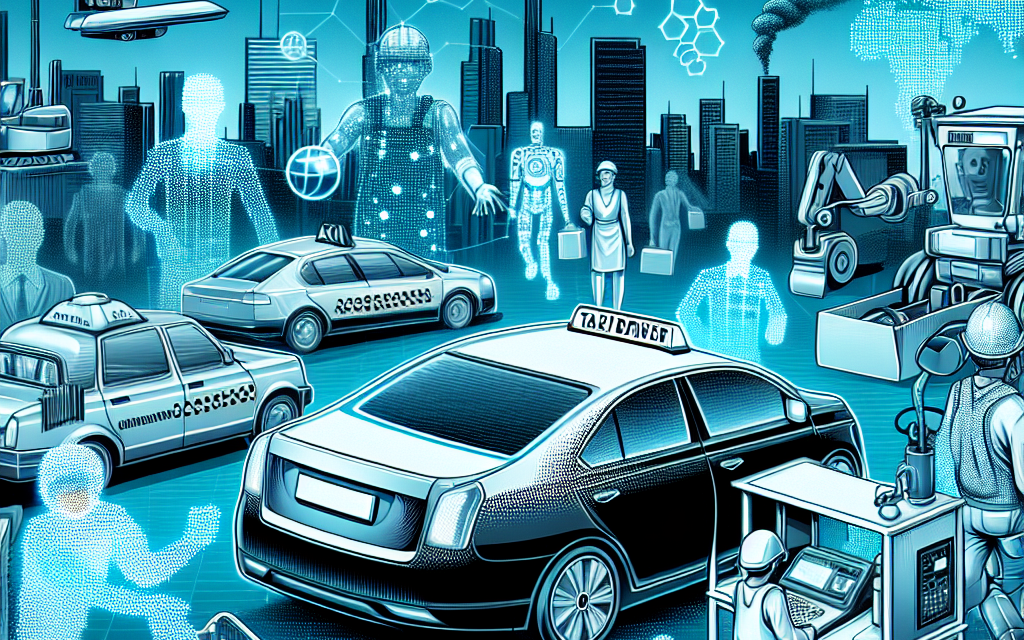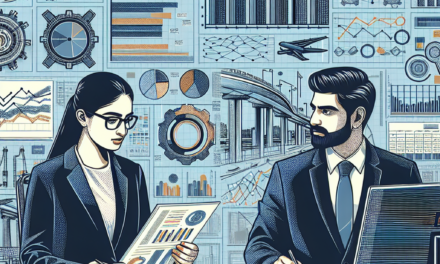“Navigating Tomorrow: The Jobs at Risk by 2030 in the Age of AI.”
Introduction
As artificial intelligence (AI) continues to advance at an unprecedented pace, the job market is undergoing significant transformations. According to the World Economic Forum, certain occupations are at a heightened risk of disappearing by 2030 due to automation and AI technologies. This report highlights the fastest disappearing jobs, emphasizing the need for workers to adapt to the evolving landscape. The findings underscore the importance of reskilling and upskilling to remain competitive in a future where AI plays an increasingly central role in various industries. Understanding these trends is crucial for policymakers, educators, and individuals as they navigate the challenges and opportunities presented by this technological revolution.
Retail Cashiers: The Shift to Automated Checkout
As the landscape of employment continues to evolve, the role of retail cashiers stands at the forefront of transformation, primarily driven by advancements in artificial intelligence (AI) and automation technologies. According to the World Economic Forum, the shift towards automated checkout systems is poised to significantly impact the demand for traditional cashier positions by 2030. This transition is not merely a trend but a reflection of broader changes in consumer behavior and technological capabilities that are reshaping the retail sector.
The rise of automated checkout systems, including self-service kiosks and mobile payment applications, has already begun to alter the shopping experience. These innovations allow customers to scan and pay for their items without the need for human interaction, streamlining the purchasing process and reducing wait times. As consumers increasingly embrace these technologies for their convenience, retailers are incentivized to adopt automated solutions to enhance operational efficiency and reduce labor costs. Consequently, the role of cashiers, which has long been a staple in retail environments, is becoming increasingly redundant.
Moreover, the integration of AI into retail operations extends beyond simple checkout processes. Advanced algorithms and machine learning systems are being employed to analyze consumer purchasing patterns, optimize inventory management, and personalize marketing strategies. This data-driven approach not only improves the overall shopping experience but also diminishes the necessity for human cashiers, as many of the functions traditionally performed by these workers can now be executed by machines. As retailers invest in these technologies, the demand for cashiers is expected to decline sharply.
In addition to the technological advancements, the ongoing global shift towards e-commerce further exacerbates the challenges faced by retail cashiers. The COVID-19 pandemic accelerated the adoption of online shopping, leading to a significant increase in digital transactions. As consumers become more accustomed to purchasing goods online, the need for in-store cashiers diminishes. Retailers are increasingly focusing on enhancing their online platforms, which often require fewer human resources compared to traditional brick-and-mortar stores. This shift not only impacts cashiers but also raises questions about the future of various retail positions that rely on in-person interactions.
While the decline of cashier roles may seem alarming, it is essential to recognize that this transformation also presents opportunities for workforce adaptation. As the demand for traditional cashier positions wanes, there is a growing need for skilled workers who can manage and maintain automated systems. Retailers will require employees who can oversee the technology, troubleshoot issues, and provide customer support in a more complex retail environment. This shift necessitates a reevaluation of workforce training and development programs to equip workers with the skills needed for emerging roles in a technology-driven retail landscape.
In conclusion, the future of retail cashiers appears increasingly precarious as automated checkout systems and e-commerce continue to reshape the industry. The World Economic Forum’s insights into the fastest disappearing occupations underscore the urgency for both workers and employers to adapt to these changes. While the decline of cashier roles may pose challenges, it also opens the door to new opportunities that emphasize technological proficiency and customer engagement in an evolving retail environment. As we move towards 2030, the ability to navigate this transition will be crucial for both individuals and the retail sector as a whole.
Data Entry Clerks: The Rise of Intelligent Automation
As we advance further into the era of artificial intelligence and automation, the landscape of employment is undergoing a significant transformation. Among the occupations facing the most substantial risk of obsolescence by 2030 are data entry clerks, a role traditionally characterized by repetitive tasks and minimal decision-making. The World Economic Forum has highlighted this trend, emphasizing how intelligent automation is poised to reshape the workforce, particularly in sectors reliant on data management and entry.
Data entry clerks have long been essential to organizations, tasked with inputting, updating, and maintaining information in databases and systems. However, the advent of sophisticated AI technologies has begun to render these roles increasingly redundant. Intelligent automation systems, equipped with machine learning algorithms and natural language processing capabilities, can now perform data entry tasks with remarkable speed and accuracy. These systems can extract information from various sources, including scanned documents and emails, and input it into databases without human intervention. Consequently, the efficiency and reliability of AI-driven solutions are compelling organizations to reconsider their reliance on human data entry clerks.
Moreover, the economic implications of this shift are profound. Businesses are constantly seeking ways to reduce operational costs and enhance productivity. By adopting intelligent automation, companies can streamline their processes, minimize errors, and allocate resources more effectively. This transition not only leads to cost savings but also allows organizations to focus on higher-value tasks that require human creativity and critical thinking. As a result, the demand for data entry clerks is expected to decline sharply, as companies prioritize investments in technology over human labor for these routine functions.
In addition to the economic factors driving this change, the evolving nature of work itself plays a crucial role. The modern workforce is increasingly characterized by a demand for skills that complement technology rather than compete with it. As AI systems take over mundane tasks, the emphasis shifts toward roles that require analytical thinking, problem-solving, and interpersonal skills. Consequently, data entry clerks may find themselves at a crossroads, needing to adapt to a rapidly changing job market that favors more complex and nuanced skill sets.
Furthermore, the implications of this trend extend beyond individual job loss; they also raise broader questions about workforce development and education. As certain occupations become obsolete, there is an urgent need for reskilling and upskilling initiatives to prepare workers for the jobs of the future. Educational institutions and training programs must evolve to equip individuals with the competencies required in an increasingly automated world. This includes fostering skills in data analysis, digital literacy, and technology management, which are essential for thriving in a landscape where AI plays a central role.
In conclusion, the rise of intelligent automation is reshaping the employment landscape, with data entry clerks among the most vulnerable to displacement by 2030. As organizations embrace AI technologies to enhance efficiency and reduce costs, the demand for traditional data entry roles is expected to diminish significantly. This shift not only highlights the need for workers to adapt and acquire new skills but also underscores the importance of proactive workforce development strategies. As we navigate this transition, it is crucial to recognize the potential of technology to augment human capabilities rather than merely replace them, paving the way for a future where humans and machines collaborate to achieve greater outcomes.
Telemarketers: The Impact of AI-Powered Communication
As artificial intelligence continues to evolve and integrate into various sectors, the landscape of employment is undergoing significant transformation. One occupation that stands at the precipice of obsolescence is telemarketing. The World Economic Forum has highlighted this trend, indicating that by 2030, telemarketers may find their roles increasingly diminished due to the rise of AI-powered communication technologies. This shift is not merely a speculative forecast; it is a reflection of the ongoing advancements in machine learning, natural language processing, and automated systems that are reshaping how businesses engage with consumers.
Telemarketing has traditionally relied on human agents to reach out to potential customers, promote products, and gather feedback. However, the advent of AI-driven communication tools has introduced a new paradigm. These tools can analyze vast amounts of data to identify potential leads, craft personalized messages, and even conduct conversations with customers in real-time. As a result, businesses are beginning to recognize the efficiency and cost-effectiveness of employing AI systems over human telemarketers. This transition is not only about reducing labor costs; it also enhances the customer experience by providing immediate responses and tailored interactions that were previously unattainable through human efforts alone.
Moreover, the capabilities of AI extend beyond mere communication. Advanced algorithms can predict consumer behavior, allowing companies to target their marketing efforts more effectively. This predictive analysis enables businesses to engage with customers at the right time and through the right channels, further diminishing the need for traditional telemarketing methods. As AI continues to refine its understanding of consumer preferences, the role of human telemarketers becomes increasingly redundant. Consequently, the job security of telemarketers is at risk, as companies prioritize technological solutions that promise higher returns on investment.
In addition to efficiency and cost savings, AI-powered communication offers scalability that human telemarketers cannot match. A single AI system can handle thousands of interactions simultaneously, ensuring that no potential customer is overlooked. This scalability is particularly advantageous for businesses looking to expand their reach without proportionately increasing their workforce. As companies adopt these technologies, the demand for human telemarketers is likely to decline sharply, leading to significant job losses in the sector.
Furthermore, the implications of this shift extend beyond the immediate job market. As telemarketing roles diminish, the workforce will need to adapt to the changing landscape. Workers in this field may find themselves needing to acquire new skills to remain relevant in an increasingly automated world. This transition could lead to a broader societal challenge, as individuals who have built their careers in telemarketing may struggle to find new opportunities in a job market that increasingly favors technological proficiency.
In conclusion, the rise of AI-powered communication is poised to significantly impact the telemarketing industry, with the World Economic Forum projecting a steep decline in the number of telemarketers by 2030. As businesses embrace the efficiency, scalability, and cost-effectiveness of AI technologies, the traditional role of human telemarketers is likely to fade. This transformation not only threatens job security for those currently employed in the field but also underscores the need for a workforce that is adaptable and equipped with the skills necessary to thrive in an era dominated by artificial intelligence. As we move forward, it is essential for both individuals and organizations to recognize these changes and prepare for the future of work in a rapidly evolving technological landscape.
Travel Agents: The Transition to Online Booking Platforms
As we navigate the rapidly evolving landscape of employment, one occupation that stands at the precipice of significant transformation is that of travel agents. According to the World Economic Forum, the rise of artificial intelligence (AI) and online booking platforms is poised to reshape the travel industry, leading to a decline in traditional travel agent roles by 2030. This shift is primarily driven by the increasing preference for self-service options among consumers, who are now more inclined to plan and book their travel arrangements online.
The advent of online booking platforms has revolutionized the way individuals approach travel planning. With just a few clicks, travelers can access a plethora of options, from flights and accommodations to activities and transportation. This convenience has made it easier for consumers to compare prices, read reviews, and customize their itineraries without the need for intermediary assistance. Consequently, the traditional role of travel agents, who once served as the primary source of travel advice and booking services, is being diminished as more people opt for direct engagement with these digital platforms.
Moreover, the integration of AI into these online systems has further streamlined the booking process. AI algorithms can analyze vast amounts of data to provide personalized recommendations based on user preferences, past travel behavior, and current trends. This capability not only enhances the user experience but also reduces the reliance on human agents for tailored travel solutions. As a result, the demand for traditional travel agents is expected to decline, as consumers increasingly turn to technology for their travel needs.
In addition to the convenience and personalization offered by online platforms, the cost-effectiveness of booking travel online cannot be overlooked. Many consumers are drawn to the potential savings associated with bypassing travel agents, who often charge service fees for their expertise. Online platforms frequently provide competitive pricing and exclusive deals that are not available through traditional channels. This financial incentive further accelerates the shift away from travel agents, as budget-conscious travelers seek to maximize their resources.
However, it is essential to recognize that the decline of traditional travel agents does not signify the complete eradication of the profession. Instead, it highlights a necessary evolution within the industry. Travel agents who adapt to the changing landscape by embracing technology and enhancing their skill sets may find new opportunities in niche markets or specialized services. For instance, agents who focus on luxury travel, complex itineraries, or unique experiences may still thrive, as these areas often require a level of expertise and personal touch that automated systems cannot replicate.
Furthermore, the role of travel agents may transition from being primarily transactional to becoming more advisory in nature. As travelers increasingly seek unique and immersive experiences, agents can position themselves as knowledgeable consultants who curate personalized journeys that align with their clients’ interests and preferences. By leveraging their expertise and industry connections, travel agents can provide value that goes beyond what online platforms can offer.
In conclusion, the rise of AI and online booking platforms is undeniably reshaping the travel industry, placing traditional travel agents at risk of obsolescence by 2030. However, this transformation also presents an opportunity for those willing to adapt and innovate. By embracing technology and focusing on personalized service, travel agents can carve out a new niche in an increasingly digital world, ensuring their relevance in the evolving landscape of travel.
Manufacturing Workers: The Role of Robotics in Production
As we look toward the future of work, the impact of artificial intelligence and robotics on various sectors becomes increasingly evident, particularly in manufacturing. The World Economic Forum has highlighted that by 2030, certain occupations within this field are at significant risk of disappearing, primarily due to advancements in automation technologies. Manufacturing workers, who have traditionally played a crucial role in the production process, are now facing unprecedented challenges as robots and AI systems become more integrated into the industry.
The evolution of manufacturing has always been marked by technological advancements, from the introduction of assembly lines to the adoption of computer-aided design. However, the current wave of automation is unlike anything seen before. Robotics are not only capable of performing repetitive tasks with high precision but are also becoming increasingly adept at complex operations that once required human intervention. This shift is driven by the need for efficiency, cost reduction, and the ability to meet the growing demands of a global market. As a result, many manufacturing companies are investing heavily in robotic systems that can operate around the clock, significantly increasing productivity while minimizing labor costs.
Moreover, the integration of AI into manufacturing processes is enhancing the capabilities of robots, allowing them to learn from their environments and improve their performance over time. This adaptability means that robots can take on a wider range of tasks, from quality control to inventory management, further reducing the need for human workers. As these technologies continue to advance, the skills required for manufacturing jobs are also changing. Workers who once relied on manual dexterity and physical strength are now expected to possess technical skills that enable them to work alongside machines and manage automated systems.
The implications of this shift are profound. Many manufacturing workers may find themselves displaced as their roles become obsolete. The World Economic Forum estimates that millions of jobs in this sector could be at risk, particularly for those in lower-skilled positions. While some workers may transition to new roles that involve overseeing robotic systems or engaging in more complex problem-solving tasks, others may struggle to adapt to the changing landscape. This disparity highlights the importance of reskilling and upskilling initiatives to prepare the workforce for the future.
In addition to the direct impact on employment, the rise of robotics in manufacturing also raises questions about the broader economic landscape. As companies increasingly rely on automation, the nature of work itself is evolving. The traditional model of employment, characterized by stable, long-term positions, is giving way to a more fluid workforce where gig and contract work may become the norm. This shift could lead to greater job insecurity for many individuals, particularly those in manufacturing who may find it challenging to secure stable employment in an automated environment.
In conclusion, the role of robotics in manufacturing is transforming the industry at an unprecedented pace, leading to significant changes in the workforce. As we approach 2030, it is crucial for stakeholders, including governments, educational institutions, and businesses, to collaborate on strategies that support workers in navigating this transition. By investing in education and training programs that equip individuals with the necessary skills to thrive in an automated world, we can mitigate the risks associated with job displacement and ensure a more resilient workforce for the future. The challenge lies not only in adapting to technological advancements but also in fostering an inclusive environment where all workers can benefit from the opportunities that arise in this new era of manufacturing.
Customer Service Representatives: The Move to Chatbots
As artificial intelligence continues to evolve, its impact on various job sectors becomes increasingly pronounced, particularly in customer service. According to the World Economic Forum, customer service representatives are among the occupations most at risk of disappearing by 2030, primarily due to the rapid adoption of chatbots and other AI-driven technologies. This shift is not merely a trend; it represents a fundamental transformation in how businesses interact with their customers.
The rise of chatbots can be attributed to their ability to provide immediate responses to customer inquiries, thereby enhancing efficiency and reducing wait times. Unlike human representatives, chatbots can operate around the clock, offering support at any hour of the day. This capability is particularly appealing to businesses aiming to improve customer satisfaction while simultaneously cutting operational costs. As a result, many companies are increasingly integrating AI solutions into their customer service frameworks, leading to a significant reduction in the demand for human representatives.
Moreover, advancements in natural language processing and machine learning have enabled chatbots to handle increasingly complex queries. Initially, these AI systems were limited to answering straightforward questions, such as those related to order status or basic troubleshooting. However, as technology has progressed, chatbots are now capable of engaging in more nuanced conversations, understanding context, and even providing personalized recommendations based on customer data. This evolution not only enhances the customer experience but also diminishes the necessity for human intervention in many scenarios.
In addition to efficiency and cost-effectiveness, the implementation of chatbots allows businesses to gather valuable data on customer interactions. By analyzing these interactions, companies can identify trends, preferences, and pain points, which can inform future strategies and improve service offerings. This data-driven approach further solidifies the role of AI in customer service, as businesses increasingly rely on insights derived from chatbot interactions to refine their operations.
While the benefits of chatbots are evident, the implications for customer service representatives are concerning. As companies continue to invest in AI technologies, the need for human representatives may diminish, leading to job displacement for many individuals in this field. This shift raises important questions about the future of work and the skills that will be necessary in an increasingly automated landscape. As customer service roles evolve, there will be a growing demand for employees who can manage and oversee AI systems, rather than those who perform routine tasks that can be easily automated.
Furthermore, the transition to AI-driven customer service does not necessarily mean the complete eradication of human representatives. Instead, it may lead to a redefinition of their roles. Human representatives may increasingly focus on handling complex issues that require empathy, critical thinking, and emotional intelligence—qualities that AI has yet to replicate fully. In this sense, the future of customer service may involve a hybrid model, where AI and human representatives work in tandem to provide a seamless customer experience.
In conclusion, the rise of chatbots and AI technologies is poised to significantly alter the landscape of customer service by 2030. While this transformation presents numerous advantages for businesses and customers alike, it also poses challenges for those employed in traditional customer service roles. As the industry adapts to these changes, it will be essential for workers to develop new skills and embrace the evolving nature of their profession. The future may be uncertain, but it is clear that AI will play a pivotal role in shaping the customer service sector in the years to come.
Agricultural Workers: The Adoption of Smart Farming Technologies
As we look toward the future of work, the impact of artificial intelligence (AI) on various occupations becomes increasingly evident. Among the sectors most affected is agriculture, where the adoption of smart farming technologies is poised to transform traditional practices. The World Economic Forum has highlighted that agricultural workers are among those at risk of displacement by 2030, as automation and AI-driven innovations reshape the landscape of food production. This transformation is not merely a trend; it represents a fundamental shift in how agricultural tasks are performed, leading to significant implications for the workforce.
Smart farming technologies encompass a range of advanced tools and systems designed to enhance productivity and efficiency in agriculture. These include precision agriculture, which utilizes data analytics, satellite imagery, and IoT devices to optimize crop yields and resource management. By employing these technologies, farmers can monitor soil conditions, weather patterns, and crop health in real time, allowing for more informed decision-making. Consequently, the reliance on manual labor for tasks such as planting, watering, and harvesting is diminishing, as machines equipped with AI capabilities can perform these functions with greater accuracy and speed.
Moreover, the integration of robotics in agriculture is becoming increasingly prevalent. Autonomous tractors and drones are now capable of executing complex tasks, such as planting seeds and applying fertilizers, without the need for human intervention. This shift not only enhances efficiency but also reduces the physical demands placed on agricultural workers. As these technologies continue to evolve, the need for traditional labor in farming is expected to decline significantly, leading to a potential surplus of workers in this sector.
In addition to robotics, AI-driven analytics are revolutionizing how farmers approach crop management. By analyzing vast amounts of data, AI systems can predict pest infestations, disease outbreaks, and optimal harvest times. This predictive capability allows farmers to take proactive measures, further reducing the need for manual labor. As a result, agricultural workers may find themselves increasingly sidelined, as their roles become less relevant in a landscape dominated by technology.
While the benefits of smart farming technologies are undeniable, the implications for the agricultural workforce are complex. Many workers may face challenges in adapting to this new environment, particularly if they lack the necessary skills to operate advanced machinery or interpret data analytics. Consequently, there is a pressing need for educational initiatives and training programs aimed at equipping agricultural workers with the skills required to thrive in a technology-driven industry. Without such support, many individuals may find themselves at a disadvantage, struggling to secure employment in a rapidly changing job market.
Furthermore, the transition to smart farming raises questions about the future of rural communities that have historically relied on agriculture as a primary source of employment. As jobs in traditional farming decline, there is a risk of economic destabilization in these areas. Policymakers and industry leaders must consider strategies to mitigate these effects, such as promoting diversification of skills and encouraging the development of new industries that can provide alternative employment opportunities.
In conclusion, the adoption of smart farming technologies is set to significantly alter the agricultural landscape by 2030, with profound implications for agricultural workers. As automation and AI continue to advance, the traditional roles of these workers are at risk of becoming obsolete. To navigate this transition successfully, it is essential to prioritize education and training, ensuring that the workforce is prepared for the challenges and opportunities that lie ahead. By doing so, we can foster a more resilient agricultural sector that embraces innovation while supporting its workforce in adapting to a new era of farming.
Q&A
1. **Question:** Which occupation is predicted to see the most significant decline by 2030 due to AI advancements?
**Answer:** Data entry clerks.
2. **Question:** What role in customer service is at risk of disappearing by 2030?
**Answer:** Telemarketers.
3. **Question:** Which type of manufacturing jobs are expected to be heavily impacted by automation?
**Answer:** Assembly line workers.
4. **Question:** What administrative position is likely to decline as AI tools become more prevalent?
**Answer:** Secretaries and administrative assistants.
5. **Question:** Which transportation-related job is facing a high risk of obsolescence due to AI?
**Answer:** Taxi drivers and chauffeurs.
6. **Question:** What role in retail is predicted to diminish significantly by 2030?
**Answer:** Cashiers.
7. **Question:** Which profession in the financial sector is expected to be affected by AI automation?
**Answer:** Bank tellers.
Conclusion
By 2030, the World Economic Forum predicts that several occupations will face significant risk of disappearance due to advancements in AI and automation. Jobs that involve routine, repetitive tasks, such as data entry clerks, telemarketers, and assembly line workers, are particularly vulnerable. Additionally, roles in transportation, such as truck drivers and taxi operators, may also decline as autonomous vehicles become more prevalent. The conclusion emphasizes the need for workforce adaptation through reskilling and upskilling to mitigate the impact of these changes and prepare for a future where human roles may shift towards more complex, creative, and interpersonal tasks.





